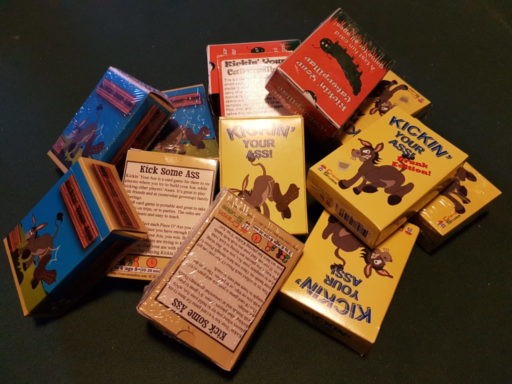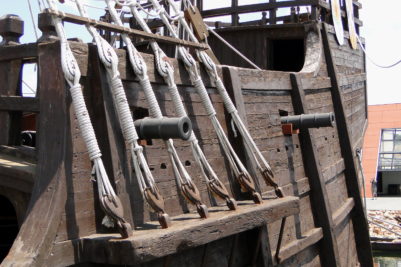The Search for Card Manufacturers
- 1.The Search for Card Manufacturers
- 2.Child Safety Testing and what it means for board games.
- 3.Selling on Amazon lesson #1 Barcodes
- 4.A lesson learned hard
The Search
So we’ve been getting ready to go to print with our card games. In choosing card manufacturers we’ve had to make some hard choices. This is our first run at making card games so we don’t have an established relationship with a particular manufacturer yet. I wanted to see what each one of the list we had would make the best product within our budget. We do of course want to have the best product for a reasonable price. For context, this is a game with 72 cards in total including rules and promo cards, and a tuck box to fit.
Price wasn’t the only considering though, and in fact it was lower on the list than some. For example card and box quality were high on the list. In fact if I were to list our considerations I’d probably list them like this:
- Print Quality
- Card and Box Quality
- Minimum order quantity
- Cost
- Production time
- Communications
There were other factors but these are the ones we looked at that helped us with our decision.
The Contenders
The manufacturers we looked at ranged from Print On Demand (PoD) to standard manufacturers. Some of the ones we looked at were:
- The Game Crafter
- Drive Thru Cards
- MakePlayingCards.com
- Cartamundi
- Panda GM
- WinGo
We went through out list and a few were eliminated right away. For example, while I would really love to have Cartamundi do all of our games, their minimum order is 3000 units and their prices are steep. They can demand that though, they used to do Magic: The Gathering and I understand that they still do handle from overflow when Hasbro can’t keep up. We also tried Panda GM, but they were really poor on the communications scale. It was difficult to get them to respond to emails and calls.
This left us with a shorter list. To make our decision I decided to get a deck made from each of the PoD companies to see how they compared. This meant loading up our card art to these manufacturers in their particular format and getting between one and five decks printed.
The Game Crafter (thegamecrafter.com)
We use The Game Crafter for our prototyping and play test copies so they were first on my list. Their online game building system is probably the best in the business. It was really easy to upload the card back which was applied across all of the cards, and then upload the different fronts and just indicate how many of each you want. They also have standard fold and glued deck boxes. They have templates you can download in various formats such as Adobe Illustrator, Photoshop, PNG, SVG and a PNG overlay if you want to use another graphics package. This makes is really easy to get your artworkk into the right dimensions for uploading. Their online system also checks the dimensions to make sure your art will fit.
Since TGC uses laser printers, graphics are uploaded in RGB color format. This is fine and it will make it easy to put your artwork online for your web site, or Kickstarter. You can reuse the card art pretty much straight out of the ones you save for upload. Which means you are saving in PNG, JPG formats. This is fine, but this can be a problem as you will see in a moment.
One of the major drawbacks to TGC is that you cannot get sorted decks. The cards come out in random order. So for example if you wanted to have your pro cards and rule cards at the front, then others behind you are out of luck. It’s a really bad experience for players when they open your game and they have to sift through the cards to find the rules and promo cards. If your game starts with a walkthrough that takes the players through a match by guiding them as they draw known cards from the top of the deck, you can’t use TGC. By contrast though they do have an ‘intentional’ randomizer which allows you to create booster packs with a certain number of classified cards. Think Magic The Gathering packs with a Rare, couple of uncommons and several commons.
This was the second major reason we didn’t go with TGC. The other reason was price. TGC is expensive. Their price breaks flatten out at 100 decks. This means that instead of the cost per deck going down as you get into higher tiers like other manufacturerS, the price for 10,000 decks is just as expensive as the price for 100. That is a deal breaker for anyone wanting to buy in bulk for distribution or anything beyond PoD or prototypes. If all you want is PoD and you don’t mind your players having to deal with a randomly sorted deck, it’s a good option. As I said earlier this is a great way to prototype your games and I will continue to use them for my prototypes.
The deck we got from them were pretty good. The actual component quality from TGC is good. It’s the packaging and presentation that let it down. The shrink wrap on the box was bubbly and very loose. It like they started to shrink it, and didn’t let
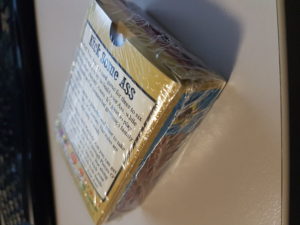
TGC Shrinkwrap
it finish.
The cards had a bit of an biased edge on them. This happens with die cutting sometimes. But it means the cards will have a tendency to stick together when you shuffle them. But the card stock and printing was excellent. The colors were even and rich.
TGC also has a huge advantage in that from their built in store system, you never have to deal with shipping and warehousing. For publishers or designers just starting out this is a massive bonus. You just have to promote your games on their site and everything else happens by magic. We are taking a different approach and doing bulk runs so this wasn’t a factor for us this time.
Eval
- Print Quality High
- Card and Box Quality Good
- Minimum order quantity Excellent (1)
- Cost Low (Pricey per deck and no break over 100 units)
- Production time Good (avg 3 days)
- Communications N/A (didn’t need to talk to anyone)
Drive Thru Cards (drivethrucards.com)
This is another PoD printer that also has DriveThru RPG, DriveThru Comics, and DriveThru Fiction. If you have a real desire to self-publish printed material, you will want to have a look at them. All of their sites are the name.com such as drivethrucards.com.
We took a look at them again because it was easy to get started and we didn’t need a sales contact or middleman to do anything for us. I gleefully charged ahead and went to upload our artwork. Here I discovered that they wanted make things differently than TGC did. For example, the tuck box art template is considerable different.
DTC uses a 4 Color Process to print their material. Which means you can’t use RGB and expect good color matching. You need to use CMYK. This alone presents some challenges if you are just starting out and you are using something like Paint.Net or some of the free graphics programs out there to do your card art. They tend to do RGB well enough, but do CMYK poorly if at all. In this case you also have to know that the JPEG format handles the CMYK a lot better than say PNG. Why does this matter? Because if you are relying on any transparency in your images to get a white card background in JPEG, you need to add a white background because it doesn’t support transparency like PNG does. PNG is a lot easier to work with from a transparency perspective, and scaling for online formats. But JPEG is much better at dealing with CMYK color profiles and is used for more 4C process printing. This meant re-exporting all of our artwork to JPEG with embedded color profiles.
The online system checks for size and color profile before accepting the artwork. However, there is a bug in the system. Even if you upload a CMYK JPG file, the system always thinks it’s RGB. You have to click on the card image in the online system to get it to open it for proofing and then close it. Once you do that, it actually reads the color profile and knows it’s CMYK.
Another thing that was significantly different is the
tuck box layout. While TGC uses basic fold and
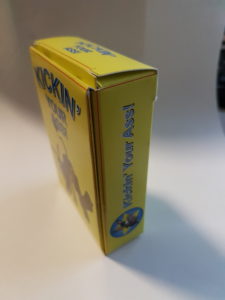
DTC Tuckbox
glue tuck boxes, DTC does not. DTC uses a non-glue folded tuck box. This means that they have a much longer box template and it’s oriented differently than standard tuck box templates. This required a whole new tuck box layout. This also means that it’s not reusable across different manufacturers. Now, very few of them are exactly reusable from one manufacturer to another but at least they are close for front, back and side dimensions etc. Not so with DTC. There is a benefit to it though.
With the DTC tuckbox, since the players can easily unfold the entire thing and lay it almost flat, you can add graphics inside the box and under flaps where it would normally never be seen. This has two uses.
One use could be to hide Easter Eggs for your players to discover. Game Art, factoids, maybe
even a coupon. Alternatively you could use the unfolded box as a game board.
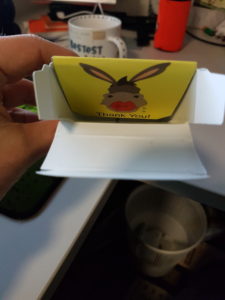
DTC Tuck Box Inside
TGC just introduced what they call Hook Boxes that can be used in a similar fashion. This may be something you want to consider if you are building a micro-game that is not just cards. In our case though, that was not a factor. However the single folded box does mean there is no thumb cutout to open the top with and this can be a pain.
The online system for DTC was ok. They have a new online upload system in place for Poker sized cards. It’s in beta and It doesn’t work for other card sizes. It then creates a layout you have to fill in. You then upload your art and you have to match card faces to card backs then drag then into a list and add a quantity for each card. This is not a bad system, but it’s still in Beta so I expect it to get much better. This does however allow you to specify the order the deck is in. You have complete control over the deck sequence. If your game starts with a walkthrough that takes the players through a match
by guiding them as they draw known
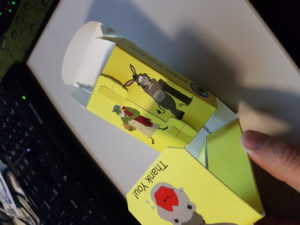
DTC Tuck Box unfolded
cards from the top of the deck, this is exactly what you need.
The price on DTC was acceptable and in actuality slightly cheaper than TGC but also flatlined at 100 units.
Adding the tuck box design was yet another issue. Not only was it in a unique layout, but it was not easy to see how or where to do it. That again is probably due to the card system being in Beta and the box system being used for other products as well.
The product we received from them was pretty high quality. The cards were evenly cut with no bias. They shuffled well and the colors were even. The shrink wrap was excellent and what I would expect to see in any store. However, the novelty of the all fold box kind of wore off. While it was cool to see the little extra graphics inside, the extra folds on the front make the box feel bulky. So if you need to use the box as a game board go for it but if you have a card game only, it might be fun at first and annoying later.
Eval
- Print Quality High
- Card and Box Quality Good (novel but clunky)
- Minimum order quantity Excellent (1)
- Cost Low (Pricey per deck and no break over 100 units)
- Production time Excellent (1 day)
- Communications N/A (didn’t need to talk to anyone)
Make Playing Cards (makePlayingCards.com)
The next one we looked at was MPC. These guys have a good reputation and have a lot of accessories and all things ‘card and casino’ related.
Their system allows you to upload all of your art first and then place it into sheets. So if you want 8 of one card and 6 of another you have to lay out 14 cards on the page with an individual back for each. This was somewhat clunky. But essentially you are doing everything a layout person does. With the added pain of their box designn upload being a strangely separate process for a system that has been in place for some time. You do all the fronts, then you do all the backs. Seems to me that they should be able to apply the same back to all the cards without you having to do in and add an image for each card back.
The good news on that front is that they use standard tuck boxes. The tuck box design is a standard folded and glued box. However, it’s not like the one from TGC which meant a new layout. The good part was that it is pretty much a mirror image. So all of the sides of the box are the same dimensions. I just had to move the graphics around and it was ready in a few minutes. Getting the template for the box was a bit of a challenge as it was not intuitive to find. The template is excellent though and easy to work with.
They accept most file types such as jpg, bmp, png, gif and tiff. They also accept either RGB or CMYK. Just note that you may get faded colors if you use RGB.
Their pricing is pretty good. It doesn’t flatline and cost continues to reduce as you go up in quantity. However they do start out a bit higher than DTC. For one deck as a prototype, they were the most expensive so far. Including shipping it was very high. So I was curious about the quality. Is it worth the cost?
The product we received from them was by far
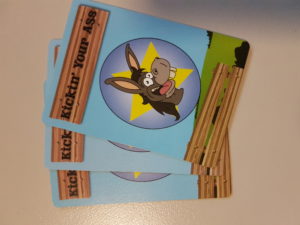
MPC Color Variation
the best quality. The box was well shrink wrapped. The deck was also wrapped and had the pull to unwrap it. The cards were well cut, but there was an issue. The colors were not consistent from one card to the next. There was what I would consider significant variation in the colors. If they would have varied between decks that would have been acceptable, but with that much variance between cards in the same deck, it’s too easy to notice. That being said, they were in the lead so far for price and quality of the finished product despite the color variation.
Eval
- Print Quality Average (quality was good,
color consistency was bad) - Card and Box Quality High
- Minimum order quantity Excellent (1)
- Cost Good (Lower base and quantity price breaks)
- Production time Good (avg 3 days)
- Communications N/A (didn’t need to talk to anyone)
UPDATE 19 Sept 2017:
Since I posted this originally, MPC contacted me concerned about the quality and the color matching. They recognised a problem and addressed it. They offered to correct the problem and worked hard to do so. I have received a new deck from them and the results are much better.
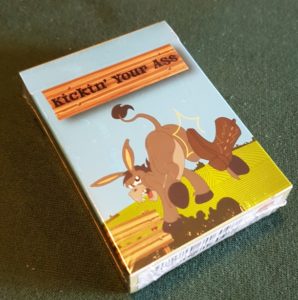
New MPC Shrink Wrapped Box
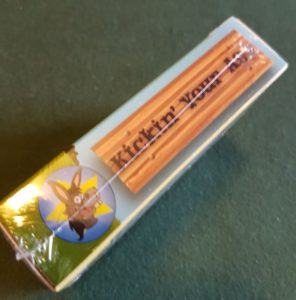
New MPC Shrink Wrapped Box edge
As you can see the Shrink wrap is still really well done. Definitely retail quality. No wrinkles or loose spots. But this wasn’t a problem before either. The finish is quite good with MPC.
The issue was the color variance. So in the image below on the left you can see the most extreme color variations of the new cards. The one on the far left and far right are the darkest of the deck, the center two are the lightest. Unless you are really looking for it, you can’t notice a difference. The color matching on this deck is near perfect. On the right, is the entire set of cards and there are no stand out color variations.

The entire set with near perfect color matching.
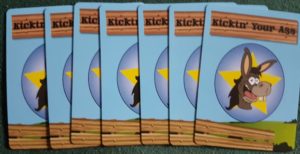
MPC Color matched cards.
Overall I’m quite happy with this result. The card faces are also well matched and printed very well.
One of the most important things to learn from this particular experience is that Customer Service counts. They did an amazing job of making this right just from seeing this article. Because of that, I know they care. They care about not only about their reputation but a happy customer, which relies on them doing a good job. And since the latter affects the former, they appear to be doing the right thing.
I definitely recommend MPC for your card game requirements.
WinGo (wingogames.com )
Wingo is a board game manufacturer that does mostly tabletop board games. It occurred to me that the games they make have cards in them and some of the games they’ve produced I know have pretty high quality components. So I thought I’d ask about card game quotes. I had a response within hours. I told them the specs of the game, 72 cards, 4C process art, tuck box etc. They quickly came back with a quote and sent a sample.
The quality is on par with MPC. Their responsiveness is excellent. Their prices are the best I’ve seen so far.
They use standard tuck boxes so the art was easy to put into their box template. Rather than using an online upload system they sent templates for the cards. A single PDF with a space for a front and a back for the cards. You put the art in there, and say you want 8 of those, 6 of these, 4 of these etc. One page (PDF) for each unique card. The art is the same that we use for DriveThru because it’s also 4C CMYK but it’s put into their PDFs instead of just uploaded as individual images.
WinGo will also do all the layout for you if you like. You can send them Illustrator files and they’ll do everything else. They also do a single laser print prototype that you proof prior to a production run. The laser printing has been tuned to exactly mimic the tone of the 4C process so you know what you will get in production. However, this is a costly prototype. They are set up for large print runs so ordering single units or doing PoD with them is not possible.
Eval
- Print Quality High
- Card and Box Quality High
- Minimum order quantity Low (1000)
- Cost High (with this quantity the price is very low per deck)
- Production time Low(35 days for a full 1000 unit run)
- Communications Excellent <3 hours response time
Conclusion
So through this process, we have decided to go with WinGo to print our card games, and Troll Bridge for that matter. I am looking forward to seeing what they can do and to getting great looking games out to our customers. Let me know what kind of experiences you’ve had.

